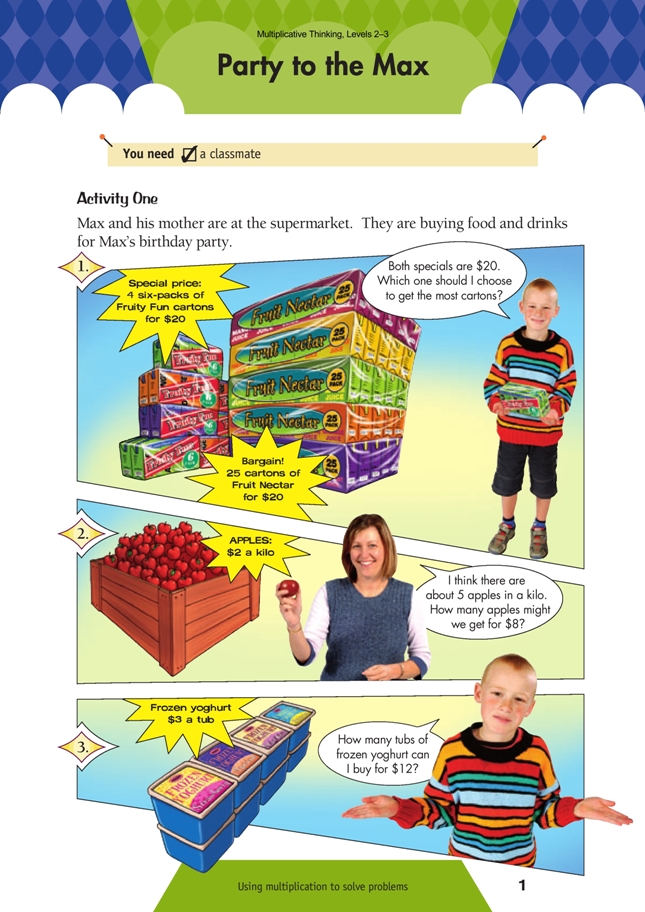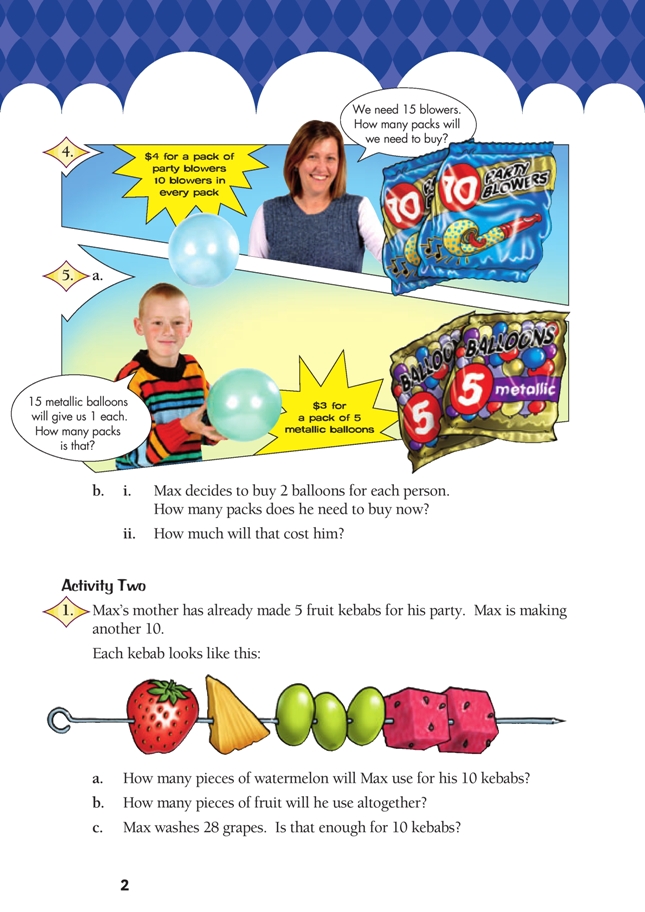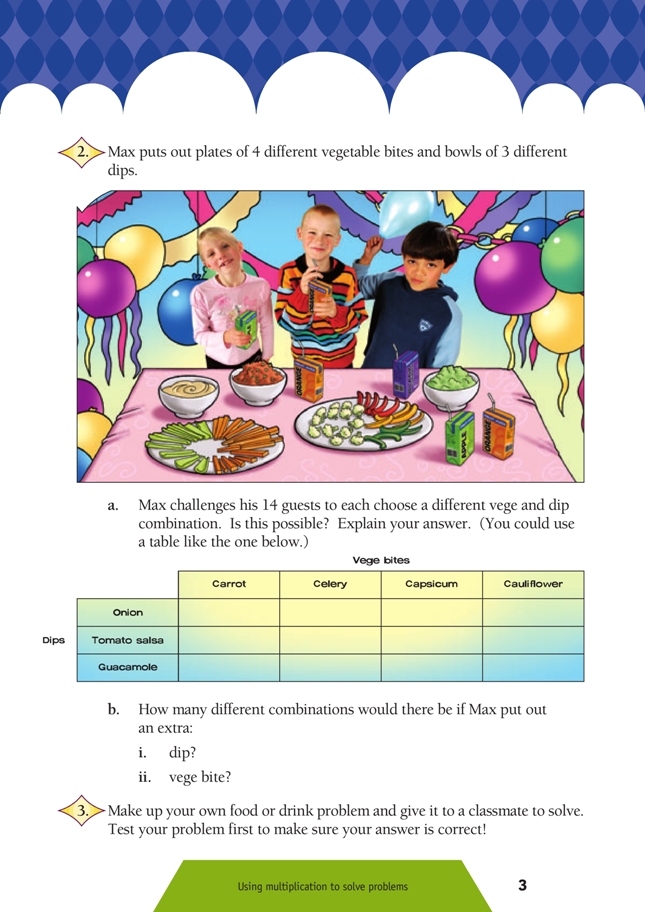This is a level 2 and 3 number activity from the Figure It Out series. It relates to Stage 5 and 6 of the Number Framework.
A PDF of the student activity is included.
Click on the image to enlarge it. Click again to close. Download PDF (1097 KB)
use repeated addition and materials to solve multiplication problems
use basic multiplication facts to solve problems
Number Framework Links Use this activity as a guided learning experience with groups at stage 4 or stage 5. It could be used as an independent activity by groups at stages 5–6.
FIO, Levels 2-3, Multiplicative Thinking, Party to the Max, pages 1-3
A classmate
Activity One
This activity presents simple multiplication and division problems in a range of ways. It provides a context for students to use and share their strategies and will also provide teachers with assessment information through observation.
The party context provides opportunities for exploring different multiplication problems and strategies. The problems emphasise different aspects of multiplication and are designed to encourage students to develop multiplicative strategies for solving them rather than relying on their additive strategies. While the numbers involved in all the problems are of a similar magnitude, students may find some more difficult than others because of the way in which a particular problem is posed.
For question 1, ask the students to identify what they need to know to answer Max’s question (How many cartons of each brand would he get for $20?), then how they will work it out. If the students want to make an array with materials, use cardboard to shield their array (or the ones on the student page) as you discuss how they could work out the answer quickly, without skip-counting. Collect students’ strategies on a shared chart and discuss them.
There are two parts to question 2: “How many lots of $2 are in $8?” and “How many lots of 5 apples will we therefore get?” The question looks very simple in its presentation but contains a lot of thinking. Ask the students to share their ideas and look for students who explain the multiplicative relationship between $2 and $8 and 5 and 20. For those who find this difficult, pose some further problems based on these numbers. For example: How many apples would we get for $10? For $4?, and so on. If we got 4 apples per kilo, how many would we get for $8?
The problem in question 3 could be solved using any of the four operations. Have the students share their strategies for this problem and record them in equations. Challenge the students who are using addition or subtraction to explain the multiplication/division methods that others may have used.
Question 4 adds the complication of “some left over”. You can extend it by asking how much Max and his mother will pay for the party blowers they need or how many blowers there would be if they bought 3 packs.
Question 5 is a two-step problem, like question 2. Watch to see if students can extend their solution methods to a new context. Part b adds further steps. For students who are struggling to use number properties or imaging, use containers or pieces of card to model the packs and counters for the balloons. Let the students use skip-counting or repeated addition to find a solution and then challenge them to find a pattern that could help them.
Activity Two
Question 1 is multiplication posed as a rate problem: “how many per?” Using the pattern for 1 fruit kebab, the students need to extrapolate to 10 kebabs. If they are having trouble solving the problem without materials, they could explore this using beads to represent the items on the kebab sticks. If they are using materials, ask them to make 5 kebabs and then see if they can find the solution without having to make all 10. Students who need further work could make their own kebab pattern, using beads or shape blocks, and then pose similar questions to others within the group.
Question 2 uses a Cartesian product presentation of multiplication, which many students find difficult to understand. In this problem type, the question is essentially “How many different pairs will these objects make?” Each of one type of object (in this case, vege bites) is paired with each of the other type (dips) to form a set of pairs. The students can complete the table on the student page to make a matrix showing the pairs. If students want to list the pairs, encourage them to be systematic as they form them: How will you know if you have got everything?
For question 3, students may struggle to structure a problem that is multiplicative. To get them started, you could use the problem types on these pages to help them frame a new problem, keeping the mathematical structure and changing the numbers and/or the context. Students will usually need a lot of support to write mathematics questions that “work”. Have a group discussion and sharing session before asking the students to complete this task. Perhaps write a few questions yourself and ask the students to comment on them. A common mistake that students at this level make is to write addition situations thinking they are multiplications, for example: “I had 3 bananas,
and I bought 4 more. How many do I have?” Help students by giving them suggestions of objects that have groupings embedded in them (for example, 12 biscuits per packet, 6 drinks per bottle).
Answers to Activities
Activity One
1. Fruit Nectar. (4 packs of Fruity Fun is 4 x 6 = 24 cartons, compared with 25 in the Fruit Nectar special.)
2. About 20 apples: 4 kg can be bought for $8 ($8 ÷ $2 = 4 or 2 x = 8), and 4 kg with approximately 5 apples in each kg is about 20 apples (4 x 5 = 20).
3. 4 tubs. (12 ÷ 3 = 4 or 3 x = 12; or $3 + $3 + $3 + $3 = 4 x $3 = $12.)
4. 2 packs. (Even though 2 x 10 = 20 is too many blowers, they need 2 packs because 1 pack is 10 blowers and that wouldn’t be enough.)
5. a. 3 packs. (There are 5 in each pack: 3 x 5 = 15 or 15 ÷ 5 = 3.)
b. i. 6 packs. (Either double the last answer or use 2 x 15 = 30. 30 ÷ 5 = 6 or x 5 = 30.)
ii. $18. (6 x $3 = $18)
Activity Two
1. a. 20. (10 x 2 = 20)
b. 70. (10 x 7 = 70)
c. No, he needs 2 more grapes because he needs 10 lots of 3 grapes, 10 x 3 = 30.
30 – 28 = 2 or + 28 = 30.
2. a. No. There are 15 people at the party, and there are only 12 different vege and dip combinations possible: 4 vege bites x 3 dips = 12 different combinations, 4 x 3 = 12.
A possible diagram is:
b. i. 16. 4 vege bites x 4 dips = 16 different combinations (4 x 4 = 16).
i. 15. 5 vege bites x 3 dips = 15 different combinations (5 x 3 = 15).
3. Answers will vary.



